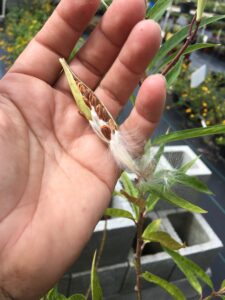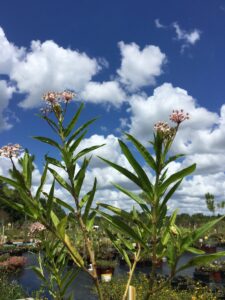S & J Nursery’s Guide to Growing
Florida Native Milkweed / Pink Swamp Milkweed / Asclepias Incarnata
for the Northeast Florida Landscape
(Asclepias incartata)
Pink Swamp Milkweed may just be my favorite of the readily available Florida native milkweed varieties, it has hardy upright and vigorous foliage with a beautiful soft pink blooms in July.
A WORD ABOUT PESTICIDES ON MILKWEEDS….
Grown as a larval plant for the Monarch, Queen and Soldier Butterfly , it is important that the plants as they have been growing have never been treated with harmful pesticides, fungicides, herbicides etc. Our butterfly plants are grown here on site from seed, cuttings, or divisions and not treated with herbicides or pesticides. Making them available without added chemical toxins to the newly hatched caterpillars as a food source also puts them on the menu for other critters like Milkweed bugs and Aphids. In reality, you can’t have one without the other. Treating them in ANY way for the removal of the aphids etc. would also harm caterpillars as well as remove or kill the unhatched eggs laid on the plants by visiting Butterflies. We like to leave them be and allow natures system of checks and balances to kick in to control pest populations. See Pesticides on Butterfly Plants for more information
Preferred Exposure for Florida Native Pink Swamp Milkweed / Asclepias incarnata:
– Prefers a bright full sun location but will still grow and bloom nicely in a
partially shaded garden location.
Foliage, Size and Growth Habit of the Florida Native Pink Swamp Milkweed /
Asclepias incarnata:
Foliage: Asclepias incarnata has opposite, narrow lance shaped light green leaves that are approximately 7.5-15 cm in length and 1-4 cm wide.
Size when Mature: It can grow to heights of 3 – 4 ft high and 2-3 ft wide in its first season.
Soil Preference / Salt tolerance of Asclepias incarnata Pink Swamp Milkweed:
Soil Preference:
Pink Swamp Milkweed is not that particular about the soil that it is planted into, providing it has consistent moisture or supplemental irrigation is provided. It will thrive when planted into moist to wet soil areas found along creek banks, ponds, wet ditches or low areas in Florida. They are ideal for those areas of the landscape that may hold excess moisture after rains like where a sidewalk slows down the drainage away from a homes foundation, or near a downspout from the rain gutters or a low area that water drains to or even just areas of heavier clay soils.
Salt Tolerance:
-Salt tolerance for Asclepias incarnata is poor.
Growth Rate of Pink Swamp Milkweed :
– Moderate to fast growing plants, Florida Native Pink Swamp Milkweed can be expected to reach its full height in the first or second growing season in the North Florida | Jacksonville |St. Augustine area landscape.
Blooms:
– Soft pink blooms in summer that are recognizable by their typical
milkweed petal pattern and count. Asclepias incarnata will have clusters of flowers that each have 10 petals , 5 down and outward facing petals and 5 upward facing petals. Collect Dried seed pods to share with other butterfly gardeners or refrigerate for a few weeks and plant out in early spring for more larval host plants to feed more of Floridas native butterfly populations!
Water Requirements:
– Asclepias incarnata will require supplemental watering when
first planted into the landscape from a container and will need supplemental watering during times of drought in the Northeast Florida landscape.
Butterfly or Bird Attracting:
– Native Milkweed will attract both butterflies and birds to your gardens
landscape including Hummingbirds! It is a larval food source for Monarch, Queen and Soldier Butterflies. Butterflies and other pollinators feed on the nectar the flowers provide.
Deer Resistance:
Deer resistant perennial plant selection
Care of Asclepias incarnata / Pink Swamp Milkweed in the Northeast
Florida | Jacksonville | St. Augustine area landscape:
– Water every other day during the establishment period, once plants have resumed growth in the landscape taper daily watering back to just a weekly application during prolonged droughts or twice weekly in dryer soil areas.
– Herbaceous perennial plant, but may be a bit slow to start in the spring, so
give them a bit of time to get growing again, they will be full of foliage to feed the butterflies by summer and blooming by the end of at July – August.
– Fertilize each spring with a shovel full of good garden compost.
Click here for more information on
Asclepias Incarnata / Pink Swamp Milkweed
for the North Florida | Jacksonville | St. Augustine area landscape.


